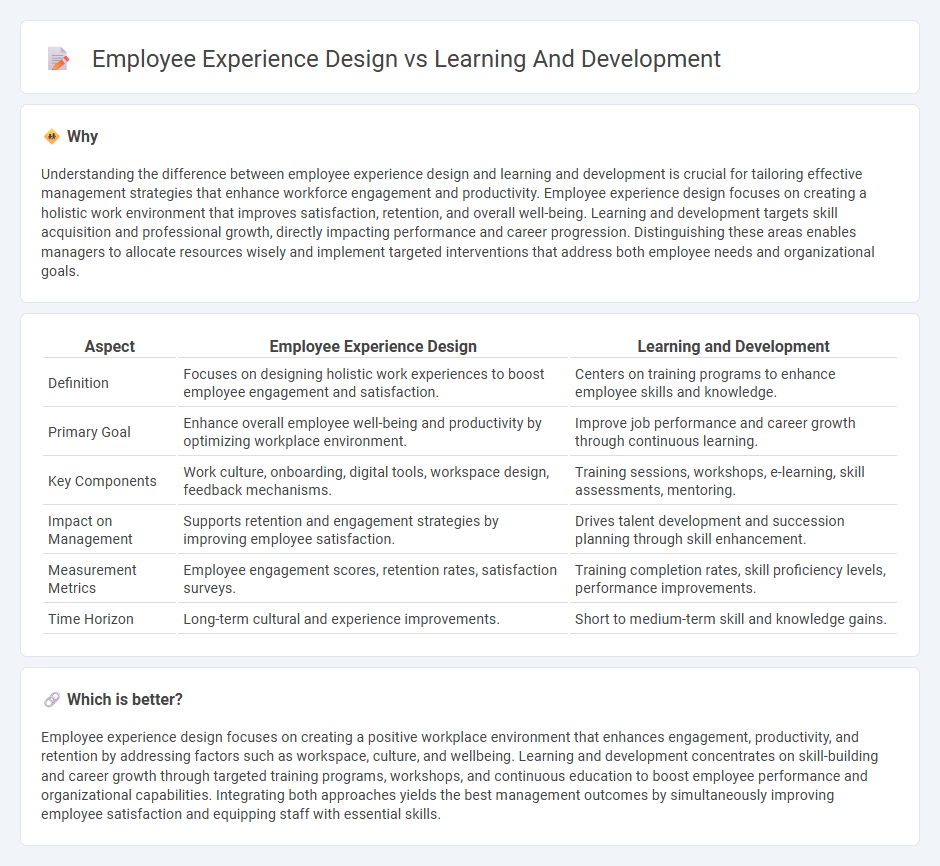
Employee experience design focuses on creating an engaging and supportive workplace environment that enhances satisfaction and productivity. Learning and development emphasizes structured training programs to improve skills and career growth. Explore how integrating both strategies can drive organizational success.
Why it is important
Understanding the difference between employee experience design and learning and development is crucial for tailoring effective management strategies that enhance workforce engagement and productivity. Employee experience design focuses on creating a holistic work environment that improves satisfaction, retention, and overall well-being. Learning and development targets skill acquisition and professional growth, directly impacting performance and career progression. Distinguishing these areas enables managers to allocate resources wisely and implement targeted interventions that address both employee needs and organizational goals.
Comparison Table
| Aspect | Employee Experience Design | Learning and Development |
|---|---|---|
| Definition | Focuses on designing holistic work experiences to boost employee engagement and satisfaction. | Centers on training programs to enhance employee skills and knowledge. |
| Primary Goal | Enhance overall employee well-being and productivity by optimizing workplace environment. | Improve job performance and career growth through continuous learning. |
| Key Components | Work culture, onboarding, digital tools, workspace design, feedback mechanisms. | Training sessions, workshops, e-learning, skill assessments, mentoring. |
| Impact on Management | Supports retention and engagement strategies by improving employee satisfaction. | Drives talent development and succession planning through skill enhancement. |
| Measurement Metrics | Employee engagement scores, retention rates, satisfaction surveys. | Training completion rates, skill proficiency levels, performance improvements. |
| Time Horizon | Long-term cultural and experience improvements. | Short to medium-term skill and knowledge gains. |
Which is better?
Employee experience design focuses on creating a positive workplace environment that enhances engagement, productivity, and retention by addressing factors such as workspace, culture, and wellbeing. Learning and development concentrates on skill-building and career growth through targeted training programs, workshops, and continuous education to boost employee performance and organizational capabilities. Integrating both approaches yields the best management outcomes by simultaneously improving employee satisfaction and equipping staff with essential skills.
Connection
Employee experience design directly influences learning and development by creating tailored, engaging environments that boost skill acquisition and retention. Integrating personalized training paths with user-centric design enhances motivation and performance, leading to measurable improvements in productivity. Organizations leveraging this synergy achieve higher employee satisfaction, reduced turnover, and accelerated talent growth.
Key Terms
**Learning and Development:**
Learning and Development (L&D) centers on enhancing employee skills and knowledge through targeted training programs, workshops, and continuous education to improve job performance and career growth. This approach directly impacts organizational success by fostering a skilled workforce capable of adapting to evolving business needs and technologies. Explore more about how strategic Learning and Development initiatives can transform your organization's talent capabilities.
Training Programs
Learning and development centers on structured training programs aimed at enhancing employees' skills and knowledge to boost performance and career growth. Employee experience design integrates these training efforts within a broader strategy that prioritizes employee engagement, satisfaction, and overall workplace culture. Explore how combining these approaches can maximize workforce potential and retention.
Skill Gap Analysis
Skill gap analysis in learning and development centers on identifying specific competencies employees lack to tailor targeted training programs that enhance performance and productivity. Employee experience design incorporates this analysis to create personalized growth pathways, fostering engagement and retention through meaningful development opportunities. Explore how integrating skill gap analysis transforms both learning strategies and employee satisfaction metrics.
Source and External Links
Learning and Development: A Comprehensive Guide - AIHR - This guide provides an overview of learning and development (L&D) as a systematic process to enhance employees' skills and competency for better performance.
L&D: What Is Learning and Development? - Coursera - This article explains how L&D helps companies retain talent, improve culture, and engage employees by improving skills and providing growth opportunities.
Learning and Development Importance [Updated 2025] - Kaltura - This blog highlights the importance of investing in L&D to foster team bonding and build a more attractive company culture.
 dowidth.com
dowidth.com